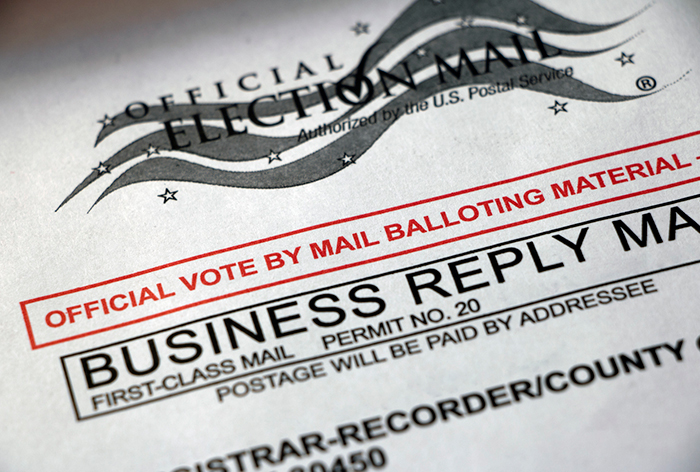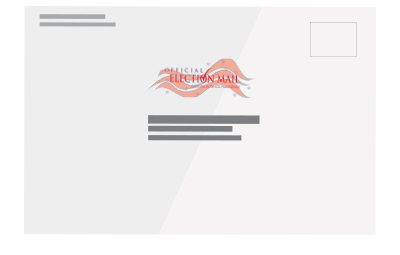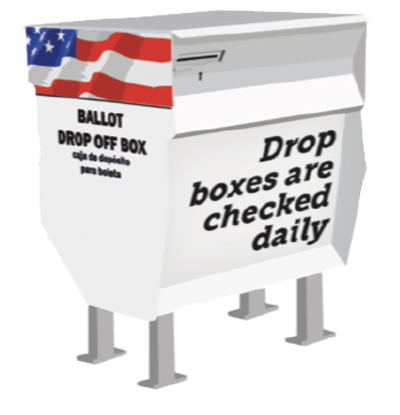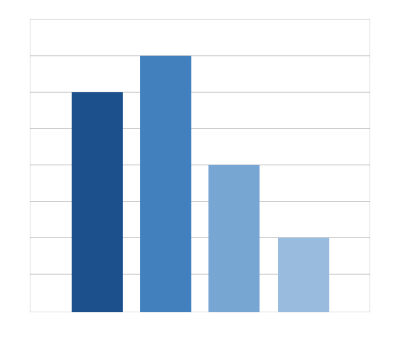The lifecycle of your ballot: Mail-in ballot processing & security
Posted on October 16, 2020 at 6:00 am

By Dana Mannino
It’s election season! A steady stream of cars flows through the library parking lots as voters drop their ballots in white collection boxes. This year, we’ve received quite a few questions about what happens to a voter’s ballot, including: “Is it safe in the ballot box?” and “How are the signatures on the ballot envelopes validated?”
I went to an expert to find out. In Spokane County, elections are supervised by County Auditor Vicky Dalton. Statewide, elections are supervised by Washington Secretary of State Kim Wyman. I read up on some existing interviews with Wyman and caught up with Dalton on the phone. So here you have it folks—straight from the experts—a bird’s eye view of the life of your ballot.

Ballot printing, testing & mailing
More than 6 weeks before Election Day, ballots are designed and sent to a printer. One size does not fit all when it comes to ballots. Here’s what I mean by that.
Elected officials represent people who live in specific geographic districts, so the names that appear on your ballot are specific to the area in the county where you live. Other voters in different areas have different ballots than yours with the names of the candidates for the positions that represent their area. This means multiple versions of the ballot are needed in every election.
Before the election, the printer sends proofs of each version of the ballot to the county elections office, where they are tested in the tabulation machines to make sure they will be read properly. Once approved, the printer prints the official ballots and envelopes and sends them to the county elections office. From there ballots are mailed out to the voters.
This year, ballots were sent out one week early, giving voters more time to vote and easing concerns about a potential slow down at the post office.
The elections office works in very close collaboration with the post office. Dalton considers Washington’s post offices to be in a better position than many states to deliver election mail on time. Whereas other states are facing a sudden and dramatic increase in the number of ballots handled via mail, Washington has been a vote-by-mail–only state since 2011.
“It’s like muscle memory,” Dalton says. “Washington state post offices have done this before. They are accustomed to the volume.”
During election season, county auditors and postal officials hold daily conference calls so that potential problems can be caught early.

Voter roll maintenance
Part of the task of the county auditor is to make sure that ballots are mailed to actual voters, not to houses where people used to live or to deceased voters. Keeping the voter list accurate and clean is called “roll maintenance.”
Washington state was one of the founding members of a program that allows states to compare their voter rolls to the rolls of other states, in order to make sure that voters are not registered in multiple states simultaneously. Forgetting to cancel your old voter’s registration when you move is common. Using your move as a way to commit voter fraud is not.
When the program was first initiated, an audit comparing Oregon voters with Washington voters found that 50,000 voters were officially registered in both states, but only 25 of them had actually attempted to vote twice. Comparing voter rolls allows states to remove this chance altogether.
Washington state voter rolls are also checked against the social security death index to make sure that no voters are dead, against the Department of Corrections (DOC) database to make sure that no voters are felons currently under DOC supervision, and against the department of licensing database to verify identity and address. Through these methods, 20–30 percent of the records on the roll are reviewed every year.
Even with all this checking, there are legitimate situations where a person might receive more than one ballot. Dalton gave the following example:
“This year ballots were sent out on October 8th. Let’s say you moved, and you updated your address on October 19th. You will have already received your original ballot at your old address. But your new address is now in a new legislative district, and you are eligible to vote for a different set of races. So we send you a replacement ballot to your new address, with an insert that explains why you are receiving a second ballot.
“If, in the meantime, you got antsy and you sent your original ballot in, your vote will still only be counted once. The barcode on your original envelope no longer corresponds with the precinct on your voter registration. So we will know that your first ballot was a cancelled ballot. We will hold that ballot and wait for your new ballot to arrive. If we don’t receive the second ballot, we will process the original ballot, but we will not count your vote for candidates or initiatives specific to your old legislative district, in which you no longer live.”

Filling out & casting the ballot
Once the ballot arrives at the voter’s mailing address, it’s time for the voter to fill it out. Dalton has some tips to make sure that your vote is counted quickly.
First, don’t eat or drink around your ballot. If a ballot is stained or water damaged, it can’t go through the ballot tabulation machines and must be re-copied by hand by elections office employees before it can be counted.
Second, make sure you are voting with this election’s ballot and sealing your ballot in this election’s envelope. If you sometimes forget to vote, old ballots might be floating around your house. Dalton states that people do mix up envelopes and ballots from prior years.
“We sometimes get this election’s ballots tucked into last election’s envelopes,” Dalton says.
The ballot sorting machines can detect an old envelope, and the ballot inspectors and tabulation machines can detect an old ballot, but this will lead to a delay in counting your vote. So, if you have old ballots or envelopes lying around from prior elections, please shred them and use only the current ballot and envelope.
Finally, please don’t sign your envelopes while you are holding it against someone’s back or on the hood of a car or on the top of the ballot box. That can distort your hand writing, casting doubt on your signature.
“We always recommend that you sign the envelope while sitting at your kitchen table,” Dalton says.

Dropping off the ballot
Dropping off the ballot is another place where voters have an important role in ballot security. Voters should never hand their ballot to anyone except a postal worker. If someone offers to turn in your ballot for you, politely and firmly refuse. You want to make sure your ballot goes straight into an official ballot box and isn’t tampered with or lost.
Speaking of boxes, voters have two options for dropping off their ballots. They can place them in a blue US Postal Service mailbox or in a white Spokane County Elections office ballot box, like the ones we have outside of the library.
At the library, ballots are occasionally misplaced inside the book drop rather than the election box. The library has procedures in place to keep your ballot secret and safe: two library employees together must deposit the ballot in the white ballot box, and the book drop is checked more frequently on Election Day. This year, staff will be on the lookout for ballot envelopes that end up in the book drop and will put them in the ballot box right away if they see them. If the ballot envelopes get mixed in with returned materials and staff doesn’t see them, it may be three days before ballot envelopes are found.
To be absolutely sure that your ballot goes in the ballot box on time and is counted in the election, keep it in a separate place from your library books, and place it directly in the white ballot box outside of the library.
For those voters who choose to drop their ballot in a blue US Postal Service mailbox on Election Day, be sure to check the collection time printed on the mailbox. If the last pickup of the day was at 3pm, and you are there at 5pm, your ballot will not be postmarked on Election Day, so it will not be counted.
The white election ballot boxes are the most direct ballot casting option. A lot of thought has gone into the design and placement of bins to keep your ballot safe.
Dalton says, “Ballot security starts with where we choose to place our bins. We place our bins at the libraries because public libraries get a lot of foot traffic, and they are very well lit buildings. We know that a lot of people would be observing them, customers as well as staff. The boxes are both accessible and safe.”
The boxes themselves are made of extremely heavy steel.
Dalton tells of one incident where a ballot box outside the downtown library was struck by a car: “The box survived, but the car didn’t make it very far after that. It basically rolled back across the street and that was it.” The box was crumpled beyond repair, but it did not open. Dalton shares how the ballot box survived, “The white ballot boxes are sealed with padlocks, steel bars, and seals to make sure that, once ballots go into a box, they stay in the box until my employees retrieve them.”

Ballot collection
Spokane County Election officials remove the ballots from most white bins either daily, or every other day for a few smaller bins, throughout the election cycle, and more frequently on Election Day.
If a bin at the library starts to get overfull, library staff can call the elections office to request a pickup. Only official election office employees are allowed to handle ballots. The elections office does not accept volunteers to handle ballots, and all elections office employees take an oath to uphold election security.
“This provides important accountability,” Dalton explains. “Employees are screened, hired, trained, supervised, and, if need be, fired.”
On election night, teams of two employees lock the boxes promptly at 8 o’clock so no more ballots can be placed in the slot, and then they remove the ballots already in the boxes. Two employees must be present any time ballots are accessible. The ballots are placed in a canvas mail bag that locks, and then they are transported to the election processing center.

Sorting
At the election processing center, the ballots, in their two layers of envelopes, go through a sorting machine. It scans the barcode on the first envelope. The barcode matches the envelope to a registered voter, and it captures a digital image of the signature on the envelope. After this process, voters can confirm that their ballot has arrived at the processing center by visiting the Spokane County Elections website and clicking on the “Track Your Ballot” button.
Envelopes go through the sorting machine twice. The first time the machine uploads images of the signatures for the election officials to review. If there is no signature, the envelope is placed in a special batch for steps explained below. After signature review, the envelopes are sent through the machine again. This time, the machine groups envelopes with approved signatures into batches of 200, and staff prepare accompanying tracking paperwork. From this point on, the information you find when you “track your ballot” refers to your ballot’s batch of 200.
In the second sorting, the machine also separates out envelopes that have been flagged for having problematic signatures. These are set aside for next steps.

Signature matching
If the envelope was not signed. A letter is sent to that voter with instructions about how to “cure their signature,” so that their vote can be counted. The voter may also receive a phone call, if the elections office has a valid phone number on file for the voter. The letter usually goes out the same day, and the voter has until the day before the election is certified to respond. This year, that date is November 23.
If the envelope has been signed, trained elections office employees compare the signature to the voter’s official reference signatures. There are three sources of signatures that are considered valid as reference signatures: the signature on a voter’s registration form, the signature on a department of licensing record, or the signature on a signature update form. Signatures on prior ballot envelopes cannot be used as reference signatures.
A human being, not a machine, compares every set of signatures. Elections employees are trained by the Washington State Patrol’s handwriting analysis team and receive refresher trainings almost every year. The signatures don’t have to be identical, but they have to match handwriting characteristics.
People’s signatures do change as they age. Dalton says there is usually a shift around age 30. If your handwriting changes enough, you may receive a letter from with a signature update form and instructions for verifying your new, more mature signature.
Questioned signatures are checked by three different employees. If all three checkers agree that it doesn’t pass, a letter is sent to the voter with instructions on how they can “cure their signature.”
There could be two possible reasons a signature doesn’t match.
1. The voter signed in an unusual way (maybe on the hood of their car), and the signature was distorted. In this case they will receive the letter and can contact the elections office and cure their signature. Signatures must be cured in person, and the individual must present valid ID.
2. Someone was attempting voter fraud. Perhaps the voter has moved, but not updated their voter’s registration. The new occupant of the voter’s old address might want to try to vote twice, and so they submit the former occupant’s ballot with a fake signature on it. In this case, the voter won’t receive the letter the election office sends, because it will go to the old address where the ballot was mailed. However, new occupants will not be able to “cure” a fake signature since they don’t have the former occupant’s ID.
If the voter doesn’t respond, that’s a red flag that this may be a case of fraudulent voting, which is a felony. The situation is handed on to the prosecuting attorney’s office.
About 2% of ballots returned each election have a problem with the signature. The majority of these are unsigned envelopes. So, double check that you signed your ballot envelope. It will save time and trouble for both you and the elections office.

Ballot counting
If the signature is a match and the ballot is still in its envelope, then it is sent in a batch of 200 ballots to the first opening station. The envelopes are hand counted to assure that the same number of ballots which left the sorting machine have now arrived at the opening station. This process is repeated at every stage of ballot processing.
At the first opening station, the outer envelope, with the voter’s identifying information on it, is opened and filed away. The ballot, still inside its security envelope, is batched and sent to the second opening station. The state constitution guarantees the secrecy of your vote, so your security envelope is not opened until the envelope with your identifying information on it is in a separate physical place.
At the second opening station, teams of two employees remove the security envelopes and inspect the paper ballot to make sure it will go through the tabulation machine. Ballots that are too damaged to go through the machine are re-copied by hand onto a clean ballot by two election employees and reviewed to be sure they match the original ballot.
The ballots are then sent through a tabulation machine. These machines have been tested before the election. Several batches of actual ballots will be identified on Election Day to be counted by both the tabulation machines and a hand count to ensure accuracy.
The machine takes an image of the ballot but doesn’t actually count the votes until election officials push a button at 8pm on election night to get the first set of results. No one is able to tell who is winning a race until after the time for voting has ended.
To prevent the possibility of hacking, the tabulation equipment is not connected to the internet. As the tabulation machines tally the votes, staff load the results on never before used thumb drives, and walk the thumb drives to a computer that is connected to the internet to upload the numbers to the county’s results page. Thumb drives are never reused.
Once counted, ballots are sent to a secure storage facility. By law they can only be accessed again for a recount, or by order of the court.
The entire sorting, opening, and tabulating process is observed by trained individuals appointed by the political parties and campaigns represented on this election’s ballot. Observers are required to stay an arm’s length away from ballots at all times. They are not allowed to bring in purses or other bags that are large enough to hold a ballot. Also, only green and red pens are allowed in the tabulation area, because those colors are not easily read by the tabulation machines.

Election Night
This year has already been a record-breaking year for voter turnout. In Spokane County, 49.72% of registered voters turned out for the 2020 August primary, compared to 34.02% in 2016. Washington Secretary of State Kim Wyman, is advising counties to prepare for a 90% turnout in this election. That’s about 311,080 ballots in Spokane County, and over 4 million state wide.
That is a lot of ballots to process, many of which may come in at the last minute. According to Dalton, as many as 50% of the ballots arrive on Tuesday, Wednesday, and Thursday of election week. It can take until Friday to make it through the mound of valid ballots.
“For this year ’s election, I am thinking it will take until early the following week,” Dalton cautions. “Please be patient. My advice is: go to bed on election night. We won’t have Spokane County elections results that include nearly all of the valid ballots until probably Monday.”
In an August interview, Wyman had an even longer timeframe in mind for the tallying of nationwide results: “I don’t think we will definitively know who will be president of the United States until the end of November.”
So that’s the inside scoop on the life of your ballot. For more information, check out these great references used to create this blog post. I would like to give a big thank you to Vicky Dalton and her team for taking time to speak with me and review this information for accuracy.
Sources
August 2020 interview with Kim Wyman and Vicky Dalton. Hosted by People for Effective Government, a non-partisan group in Spokane. Wyman and Dalton discuss election security measures at the county, state, and national levels.
Fall 2020 Observer Training from Spokane County Elections office (file download). This PowerPoint is part of the training provided to official election observers from each political party.
November 2019 Spokesman-Review article. This article describes the process elections employees go to through to count damaged or unclear ballots.
Spokane County Elections website. Here you can check to make sure your voter registration is up to date, track your ballot, and get your questions answered.

Tags: adults, ballot box, ballots, mail-in voting, voter, voting
